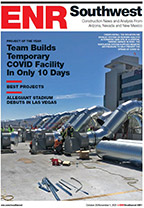Dehumidification—a suspension- cable technology well established in Europe and Japan—is finally making inroads in the U.S. The Maryland Transportation Authority recently completed a $53-million project to rewrap the main suspension cables and install a dehumidification system on both spans of the 4.3-mile-long William Preston Lane Jr. Memorial Bridge. The Delaware River and Bay Authority awarded to American Bridge a similar, $33.6-million contract that will begin next month.
Kiewit Infrastructure Co. late last year completed installation of the system on the Chesapeake Bay Bridge, says Will Pines, MDTA deputy director of engineering. The work began in 2012, after the agency considered options for the aging cables on the 2,900-ft-long suspended east span, opened in 1952, and the parallel west span, opened in 1973.
“We hired Ammann & Whitney to help us consider different ideas,” says Pines. “They presented dehumidification to us, indicating that it was ‘state of the art’ for protecting suspension cables. There was no precedent in North America, but there were 20 bridges worldwide with systems installed.”
Methods for protecting cables include oiling, lead paste and other wrapping systems, but “this system provides an extended system life of 25 to 30 years,” says Pines. “This is the only technique that actively dries the cable.”
Ammann & Whitney and AECOM developed the bid documents for a contract to install dehumidification systems for cables and anchorages on both spans. Competing bidders each constructed a test rig that reflected the dimensions of the actual cables and ran a shop trial in which the rig was pressurized to 0.725 psi, says Pines. Upon beginning work in 2012 on the westbound, three-lane span, Kiewit installed a temporary main-cable access walkway.
After completing work on the span in 2014, crews began work on the east span, using a temporary walkway, as well as a traveling gantry, for cable backstays below deck level. The east span’s anchorages are located at the water line, unlike the west span’s deck-level anchorages.
The system includes new plant rooms in the anchorages of the westbound span and one on the lower chord of the east span’s approach truss. The rooms contain the dehumidifiers and fans that distribute air through pipes into the cables through injection sleeves. The sleeves also have sensors to monitor air-flow, temperature and humidity levels.
The contract includes two years of maintenance and monitoring. According to Ammann & Whitney, data from the western span, since mid-2015, show that relative humidity rates were reduced by 40% in about nine months, the target goal. As a result, the paper states, the air injection eventually can be reduced to 0.290 psi from 0.435 psi, saving energy and wear and tear on the equipment.





Post a comment to this article
Report Abusive Comment